Map
Vagli
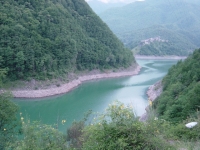
This village offers lovers of nature, the charm of its marble mountains, the quiet magic of the lake.
Youtube: Lago di Vagli: riflessi e colori
The vertiginous walls of Mount Roccandagia, the depths of karst valley of glacial Arnetola, Marmitte of the Giants, the mysterious village submerged by the waters of the lake are just some of the many attractions that make the stay an unforgettable experience in Vagli.
The village submerged
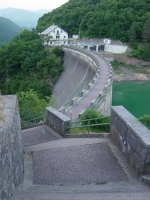
Every ten years is at Vagli an exceptional event that attracts hundreds of thousands of tourists coming from all over the world: the lake (which in reality is a large hydroelectric reservoir) is totally drained for maintenance work, bringing out as if by magic, the ghostly ruins of the village of Fabbriche Careggine of the "Ghost Village".
Village of "Vagli di Sotto"
This village is situated on an isolated hilltop, and, in the old part, has kept its structure intact. Is not accessible to the machine and one of its steep narrow streets you can walk only on foot.
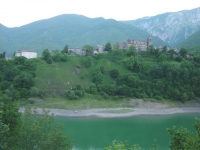
In the village center is the church of St Regulus, probably built between the twelfth and thirteenth century. In the church there is a stack of holy fifteenth century, in marble, which has four faces representing youth, manhood, old age and death, a cross of the fifteenth century, in silvered bronze, a sink that has two busts in relief, with an emblem in the center (probably of the Malaspina) and a statue of Jesus died. In addition to the church of St Regulus, are the oratories of St. Mary, and the design erected in memory of a wave of plague that plagues the country. Not far from the village there is the old convent of Augustinian nuns, hiding the church of St. Augustine, is a Byzantine-style church of the eleventh century, which served the parish church for inhabitants of Vagli di Sotto and Vagli di Soopra. It was originally dedicated to St. Regolo, then to 1390 he was transferred to the Augustinian monarchies, taking the name of the church of S. Augustine. Inside there were living about 10-15 nuns who lived with the fruit of their talents and with what obtained by knitting and cultivating adjacent fields.
Quarries of marble.
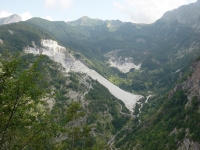
ARNETOLA: Cave of marble.
CAMPOCATINO: At the foot of Roccandagia, is of significant landscape value.
ROGGIO: Remains of an ancient fortress.
Location VERGAIA
History
The Municipality of Vagli has a rich and interesting history. Under the impending of the victorious Roman legions, it became the last refuge of the surviving tribes; Liguri Apuani-linked by relations with the Etruscan civilization as shown by recent archaeological excavations.
Were removed in some way to local lordships, "I Vaglini", around the year thousand, were organized in distinct communities Screeners di Sotto, Vagli of Above and Roggio, names that also appear in some imperial diplomas.
Already established in Roman times, in medieval times was the domain of the Lords of Careggine, then the Republic of Lucca and finally the Estensi.
In 1451 our three countries, passed with the Este of Modena and Reggio, with the lordship of which remained, except a brief encounter took place in the Napoleonic period, until the advent of the unification of Italy.
Church of St. Agostino.
charming building with two naves and two apses in cavernous limestone with adjoining former convent of Augustinian nuns. The capitals of the columns that divide the aisles retain decorative early. Next to the church of St. Augustine can be seen the remains of a convent of Augustinian nuns, deleted in 1796. Already in 1600, however, there were only twelve sisters very poor who dedicated themselves, in addition to prayer, also to works of charity, so that in 1336 turned their monastery in lazaret for those suffering from cholera.
Church of San Regolo: (a Vagli di Sotto).
Imposing building in the thirteenth century in the country, important works of medieval wooden sculpture including a Crucifix, attributed to the first workers lucchesi mid-fourteenth century and a Madonna with Child of the early fourteenth century.
The building has a single aisle in the front blocks of limestone alternating with bands of white marble.
Campocatino, Oasis LIPU
m. 1000 s.l.m.




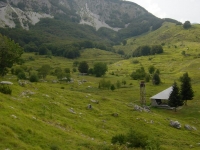
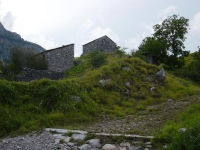
A large agrarian terracing, which is still admirable on the sorroundings slopes, testifies a considerable agricultural activity. This one had been carried out for centuries at the bottom of the Roccandagia mountain (1707 mt), commonly known as "Penna di Campocatino".
Oasis LIPU Campocatino, Roccandagia Mountain Nature Reserve.
In 1991 was established the Oasis LIPU Campocatino, managed by LIPU thanks to an agreement with the Regional Park of the Apuan Alps and in collaboration with the Municipality of Vagli di Sotto.
The Oasis is located and closed to the north by the peaks of Mount Pisanino and to the south of Mount Sumbra.
It's all included in the municipal area of Vagli di Sotto.
One the sleep and rocky southern bottom of this mountain is situated the hermitage dedicated to Saint Viviano. This is a very suggestive abri-chapel under the rock, which has ancient origins and is worth a visit. The primitive basin of Campocatino, dominates the valley and hosts a variety bird and a campfire with a restaurant.
Legends: The legend of Vagli's lake.
Tradition and elves: The Buffardello and the Linchetto.